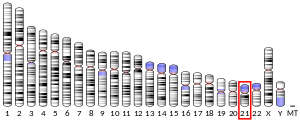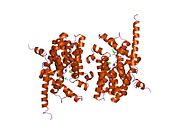High affinity cGMP-specific 3',5'-cyclic phosphodiesterase 9A is an enzyme that in humans is encoded by the PDE9A gene.
The protein encoded by this gene catalyzes the hydrolysis of cAMP and cGMP to their corresponding monophosphates. The encoded protein plays a role in signal transduction by regulating the intracellular concentration of these cyclic nucleotides. Multiple transcript variants encoding several different isoforms have been found for this gene.
Inhibitors
See also
References
- ^ GRCh38: Ensembl release 89: ENSG00000160191 – Ensembl, May 2017
- ^ GRCm38: Ensembl release 89: ENSMUSG00000041119 – Ensembl, May 2017
- "Human PubMed Reference:". National Center for Biotechnology Information, U.S. National Library of Medicine.
- "Mouse PubMed Reference:". National Center for Biotechnology Information, U.S. National Library of Medicine.
- Fisher DA, Smith JF, Pillar JS, St Denis SH, Cheng JB (Jul 1998). "Isolation and characterization of PDE9A, a novel human cGMP-specific phosphodiesterase". J Biol Chem. 273 (25): 15559–64. doi:10.1074/jbc.273.25.15559. PMID 9624146.
- ^ "Entrez Gene: PDE9A phosphodiesterase 9A".
- Verhoest PR, Fonseca KR, Hou X, et al. (2012). "Design and discovery of 6--1-(tetrahydro-2H-pyran-4-yl)-1,5-dihydro-4H-pyrazolopyrimidin-4-one (PF-04447943), a selective brain penetrant PDE9A inhibitor for the treatment of cognitive disorders". J. Med. Chem. 55 (21): 9045–54. doi:10.1021/jm3007799. PMID 22780914.
- Hutson PH, Finger EN, Magliaro BC, et al. (2011). "The selective phosphodiesterase 9 (PDE9) inhibitor PF-04447943 (6--1-(tetrahydro-2H-pyran-4-yl)-1,5-dihydro-4H-pyrazolopyrimidin-4-one) enhances synaptic plasticity and cognitive function in rodents". Neuropharmacology. 61 (4): 665–76. doi:10.1016/j.neuropharm.2011.05.009. PMID 21619887. S2CID 143527784.
Further reading
- Guipponi M, Scott HS, Kudoh J, et al. (1998). "Identification and characterization of a novel cyclic nucleotide phosphodiesterase gene (PDE9A) that maps to 21q22.3: alternative splicing of mRNA transcripts, genomic structure and sequence". Hum. Genet. 103 (4): 386–92. doi:10.1007/s004390050838. PMID 9856478. S2CID 24883234.
- Hattori M, Fujiyama A, Taylor TD, et al. (2000). "The DNA sequence of human chromosome 21". Nature. 405 (6784): 311–9. Bibcode:2000Natur.405..311H. doi:10.1038/35012518. PMID 10830953.
- Strausberg RL, Feingold EA, Grouse LH, et al. (2003). "Generation and initial analysis of more than 15,000 full-length human and mouse cDNA sequences". Proc. Natl. Acad. Sci. U.S.A. 99 (26): 16899–903. Bibcode:2002PNAS...9916899M. doi:10.1073/pnas.242603899. PMC 139241. PMID 12477932.
- Rentero C, Monfort A, Puigdomènech P (2003). "Identification and distribution of different mRNA variants produced by differential splicing in the human phosphodiesterase 9A gene". Biochem. Biophys. Res. Commun. 301 (3): 686–92. doi:10.1016/S0006-291X(03)00021-4. PMID 12565835.
- Wang P, Wu P, Egan RW, Billah MM (2003). "Identification and characterization of a new human type 9 cGMP-specific phosphodiesterase splice variant (PDE9A5). Differential tissue distribution and subcellular localization of PDE9A variants". Gene. 314: 15–27. doi:10.1016/S0378-1119(03)00733-9. PMID 14527714.
- Ota T, Suzuki Y, Nishikawa T, et al. (2004). "Complete sequencing and characterization of 21,243 full-length human cDNAs". Nat. Genet. 36 (1): 40–5. doi:10.1038/ng1285. PMID 14702039.
- Huai Q, Wang H, Zhang W, et al. (2004). "Crystal structure of phosphodiesterase 9 shows orientation variation of inhibitor 3-isobutyl-1-methylxanthine binding". Proc. Natl. Acad. Sci. U.S.A. 101 (26): 9624–9. Bibcode:2004PNAS..101.9624H. doi:10.1073/pnas.0401120101. PMC 470725. PMID 15210993.
- Gerhard DS, Wagner L, Feingold EA, et al. (2004). "The status, quality, and expansion of the NIH full-length cDNA project: the Mammalian Gene Collection (MGC)". Genome Res. 14 (10B): 2121–7. doi:10.1101/gr.2596504. PMC 528928. PMID 15489334.
- Rual JF, Venkatesan K, Hao T, et al. (2005). "Towards a proteome-scale map of the human protein-protein interaction network". Nature. 437 (7062): 1173–8. Bibcode:2005Natur.437.1173R. doi:10.1038/nature04209. PMID 16189514. S2CID 4427026.
- Hu YH, Warnatz HJ, Vanhecke D, et al. (2006). "Cell array-based intracellular localization screening reveals novel functional features of human chromosome 21 proteins". BMC Genomics. 7: 155. doi:10.1186/1471-2164-7-155. PMC 1526728. PMID 16780588.
- Rentero C, Puigdomènech P (2007). "Specific use of start codons and cellular localization of splice variants of human phosphodiesterase 9A gene". BMC Mol. Biol. 7: 39. doi:10.1186/1471-2199-7-39. PMC 1647287. PMID 17090334.
| PDB gallery | |
|---|---|
This article on a gene on human chromosome 21 is a stub. You can help Misplaced Pages by expanding it. |






